Dahlias are amongst my favourite flowers. Here I describe how to grow dahlias if you’ve never done so before.
Most of my novice gardener friends assume dahlias are beyond their skill. Maybe the mesmerising petal formations and dazzling colour variations confuse dahlia debutantes into thinking that they are hard to grow. They are not.
Coming in a variety of colours wider than Jackson Pollock’s palette, there is a dahlia out there for everyone. Dahlias have bounced back from the days when they were considered the brash gatecrasher at a debutante ball. They’re everywhere on social media in late summer and autumn – and deservedly so – but you need to plan ahead and buy your tuburs in winter if you want to grow your own stunners.
A dahlia laden with flowers and buds has great impact in the garden, and nothing is more beautiful in the autumn home than a tastefully combined bouquet, or even a brash clash in a mixed arrangement. It is rare to find them in any variety in your average florist and often not at all. The answer is to grow your own and now’s the time to shop for the ones you want before they sell out.
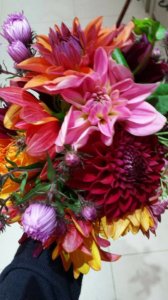
A brash clash dahlia bouquet with silvery mauve aster. You may struggle to find a selection like that in your local florist!
My dahlia story – how I learned to grow dahlias
My love affair with the dahlia began in the late 1990s when we moved to a terraced house in SW London with a tiny courtyard garden. I’d planted architecturally strong plants such as tree ferns, banana and palms. I wanted some flowers too but was a bit stumped for ideas.
Remember this was before pinterest and instagram. In the pre-broadband days of the dial-up modem we weren’t in the habit of internet inspiration. A magazine article suggested combining high impact leaves with the knock-out colour of dahlias and I went for it. I wasn’t sure how best to grow dahlias but I knew I’d figure it out.
This was at the early stages of the dahlia’s comeback as a garden flower and they weren’t widely available. I bought what was on offer in my small local garden centre, potted them up in my kitchen and waited for them to do something.
A few weeks later I was about to give up when I saw what looked like bulging bronzed pink nodules at the base of the brown stem. They were off. By late May, I had a few healthy looking plants and had even been brave enough to take some cuttings, all of which rooted.
I have no recollection which varieties I grew that first summer and the colours were, with hindsight, rather nasty; a two tone orange semi-cactus type and a garish all yellow small cactus. But you need a loud-mouth plant to keep company with bold banana, tree ferns, Crocosmia ‘Lucifer’ and acid Nicotiana ‘Lime green’ and my hot coloured dahlia more than held their own.
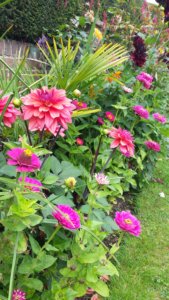
Dahlia in hot “club tropicana” colours look great in a mixed tropical border – with Trachycarpus fortunei and Zinnia.
I now have a larger garden in the Chiltern hills and I still have what I call a ‘tropical border’ with banana and trachycarpus fortunei. Every year these are joined by different dahlia and zinnia, all in hot club tropicana colours.
Last year, in another flowerbed, I branched out from my hot colour schemes and combined soft pink, white and dusky-rose dahlias with lavender, pink and mauve perennials and cool acid green flowers and thyme.
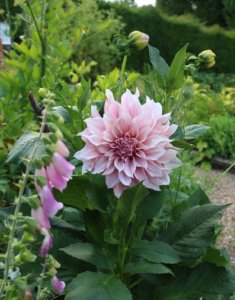
Dahlia ‘Cafe au lait’ with foxgloves and Nigella ‘papillon’ in a cooler pink and lime colour scheme
Choosing which dahlias to grow
The revival in the popularity of the garden dahlia is due in some part to the inventiveness of garden creators such as Christopher Lloyd and Felix Garrat at Great Dixter. They showed that colour clashes can be good. Garden blogger Out Of My Shed has written a great article about inspirations from Great Dixter and sourcing dahlia tuburs.
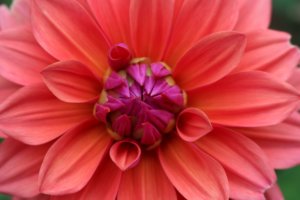
The centre of Dhalia ‘American Dawn’. The petals are two tone, with shocking pink outsides and strong coral insides.
Tubur suppliers have trialled varieties in garden and cutting patch settings. Trialling them on their own and alongside other plants they have derived colour collections that you can easily replicate at home. Sarah Raven plants really have their finger on the dahlia zeitgeist and sell many collections. Peter Nyssen are selling a 6 dahlia selection in hot colours for £12.50 and make suggestions of perennials to plant alongside in a mixed border. If you’re a newbie, collections put together by others are a great starting point and once you get your confidence up you can experiment with your own blends. I have also bought excellent quality dahlias from Gee Tee Bulb company, who sell many great varieties and a mixed collection for a cutting patch or allotment.
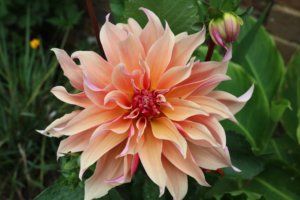
Dahlia ‘Labyrinth’ combines well with pink, mauves and burgundies. For a cool arrangement combine with baby pink.
Another great starting point is to look at gaps in your border and consider which dahlia will stun in that location. Do you need a taller variety? One with small flowers? and which colour will charmingly blend or cunningly clash with what is already there? Take time to look through catalogues. You’ll soon narrow down the options but I doubt you’ll resist the odd tubur that you’re yet to place.
Where to buy dahlias
Tuburs are now widely available from stores and online. I have bought many from online suppliers, garden centres and even from supermarkets.
The advantage of buying in a garden centre is that they are often in see through breathable plastic bags so you can take a look at the tubur and check that it isn’t damaged. Sometimes the fleshy food-storing parts of the tubur will have twisted off.
Bear in mind that not all tuburs will be the same size. Paying a bit extra for a large, healthy tubur, from a reputable online supplier may pay dividends for a stronger plant.
How to grow dahlias that are loved by bees (but also earwigs)
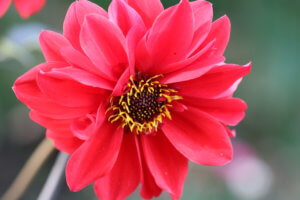
Dahlia ‘Bishop of Llandaff’ is a single variety – the pollinators find the nectar easier to reach
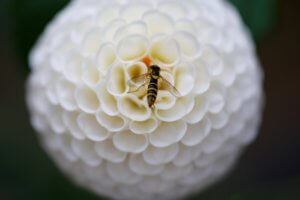
A hoverfly finding the nectar hard to access on this pompom dahlia ‘Small World’
Generally speaking, dahlias with single, unfussy petal structures – where the nectar and pollen are easy to access – will be more attractive to insects. If you want to attract pollinators such as bees and hoverflies to your garden then do choose single varieties.
Insects you don’t want near your dahlias are earwigs as they nibble the petals and ruin the look of the flower. Putting an upturned pot of straw on a stick nearby will give the earwigs somewhere to hide but it’ll only help if you’re wiling to empty and dispose of them each day. Otherwise you’re simply providing a luxury earwig hotel with gourmet restaurant nearby.
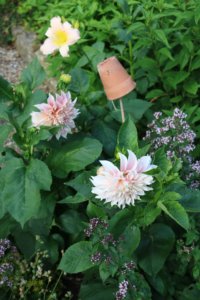
Straw-filled pot to capture earwigs. Dahlia ‘Cafe au lait’ planted with thyme and pink Hemerocallis
How to plant your dahlias
Whilst dahlias are on sale in garden centres and online from mid January, it’s inadvisable to do anything with them until late february or march. The tuburs will have been carefully washed and dried and will come to you stored in paper or plastic bags with sawdust or dried compost. They are dormant and you don’t need to worry about dealing with them until conditions are right for you. Just keep them in a cool dry place and they’ll be just fine.
If you like, you can wait and plant them straight out in the garden (with a fair dollop of manure) once the chance of frost has passed. But if you want slightly earlier flowers, or to get some cuttings underway, it’s worth potting them up and bringing them on sooner.

This way up – a dahlia tubur ready to plant – you can see the remains of last year’s stem sticking up in the centre.
If you have a greenhouse then keep them there so long as you know they won’t get damaged by frost in really cold weather. If in doubt, bring them on in the house.
- Unpack your Dahlia tuber and check it over. Each part of the tuber should be firm. Any shrivelled or rotting pieces should be taken off and discarded.
- Tubers vary significantly in size. Take a look at your tuber and work out which size pot it will fit into. To save on compost, choose the smallest pot that will fit your tuber. Fill the pot to a third full and place your Dhalia on top of the compost. You should be able to see which way up the tuber goes as the remains of last year’s stem is usually visible.
- Add more compost around the tuber and tap the pot frequently to settle the compost around it. It needn’t be fully covered and leaving the stem and top f tuber showing can help you see when it’s starting to shoot. Water and keep moist, but not wet, in a greenhouse or on a windowsill.
- Tubers vary in how quickly they come into growth. Generally speaking you should see small bulges developing on the tuber within a month but some will take longer. Heat from below (a heat mat or propagator) can be beneficial to bring a Dahlia into growth sooner.
- Pinch out the tips of the growing stems to encourage bushier growth – don’t be scared to do this – you’ll get more flowers.
- Do not plant outside until you know there will be no frost. Dig in some compost and manure before you plant and consider feeding with chicken manure throughout the growing season.
- Pick your flowers regularly and deadhead those that have gone over – again, you’ll get more flowers that way.
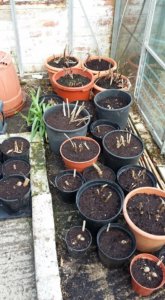
Dahlia tuburs potted up in greenhouse in March.
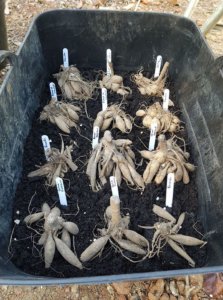
12 tuburs crammed into a large rectangular trug – Then cover with compost up to their necks.
Overwintering dahlias
This is the only tricky thing about growing dahlia and I’ve saved it to last so as not to put you off. It’s very much a judgement call. What we do know is that they will rot outside in cold, damp winters. The question is how damp and how cold? What kind of weather will we be in for in any one winter? Can you afford to replace any lost tuburs? and have you the room or environment to store them correctly over the winter?
No garden or gardener’s resources are the same so it’ll be a decision you must take alone. Helpfully the Middle Sized Garden blog produced an excellent article summarising the dahlia overwintering dilemma. It’s well worth reading to help you make your mind up and makes reference to the fact that some types of dahlia may succomb more easily to winter than others.
My experience of the dahlia dilemma is mixed. I spent the first few years as a dahlia grower digging up my tuburs, washing them off, drying them and storing in a dry shed. This was in London, in a very sheltered garden and with hindsight I really don’t think I need to have bothered. I’m pretty certain they would have survived outside and grown to be bigger, stronger plants with a great root structure if I’d been more laid-back and just let them be.
When I moved to the Chilterns, the dahlia moved with me and I lost a few that first winter, as my new shed was not only cold but very damp and full of mice and possibly rats, which appear to love nibbling on dahlia tuburs. They decimated my stock.

Dahlia tuburs hung in onion sacks to overwinter in my garage – where the mice can’t reach!
Next year I dried them much more carefully to prevent rot and placed them in onion bags hung from the rafters of my drier garage to fool the mice. It worked and they all survived but it was a labour of love and hardly an advocate for an otherwise easy to grow plant.
2017 was the first year I dug none up but covered them all in a thick mulch layer of loose home made compost in late autumn. As I write this, temperatures are due to drop to -5 overnight and we also had a cold snap and deep snow in December. I am not sure whether they will all survive but I’m optimistic as they are in well drained soil with their mulch duvet to keep them from the cold. Only time will tell but in the mean time I have treated myself to an order of some new varieties. I am a dahlia addict after all!
Summer 2018 UPDATE – I estimate that 90% of the dahlias I left in the ground have sprung up despite the very harsh winter and there is still time for a few more to do so. I have found that the biggest problem with overwintering in the ground is that the slugs and snails LOVE the new growth so if you do try this method, make sure you’re prepared with slug protection. If you don’t like slug bait, which is something I for one am reluctant to use, then keep a close eye on your plants as they emerge and pick off the slugs and snails at night. You only need to do this for while until you have strong growth.
How to take dahlia cuttings – flowers for free
Dahlias are the first flowers I ever took cuttings from. Each tubur send up multiple stems, some of which you can take as cuttings. It’s also advisable to pinch out the growing tips of each stem to make a bushier plant and some of these can also root if handled correctly.
Click here for an article which shows you a step by step guide. It also contains a little youtube video which illustrates just how easy it is.

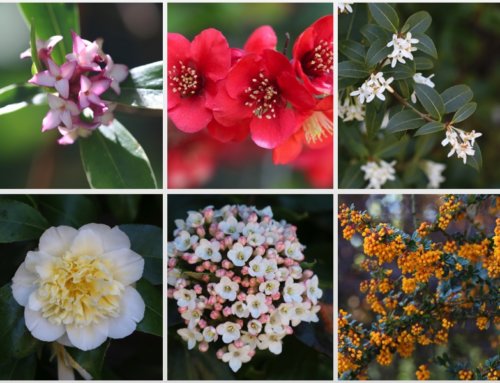
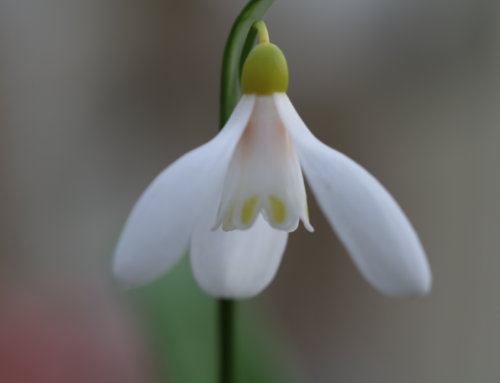
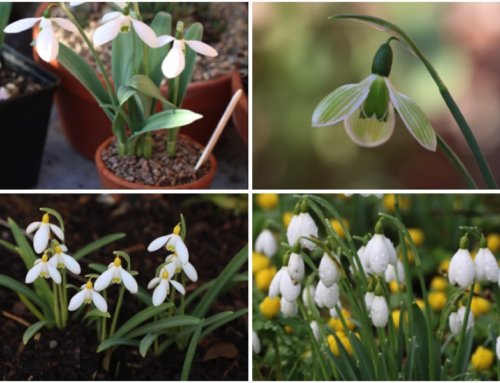
DEAR TEA BREAK GARDENER – I AM A DEVOTED TEA BREAK GARDEN BLOGGER READER AND SO ENJOYING YOUR WRITINGS – INSPIRING AND FUN. I MIGHT EVEN GET OFF MY CHAIR AND DO SOME PLANTING OF SWEETPEAS THIS AFTERNOON.
Thanks so much Susan. Lovely to hear you’re enjoying it and inspired to get out there. I have lots of changes planned in my garden. Knowing I can share what I’m doing with others has given me the impetus to turn some of my ideas into reality!
That was the best read so far on dahlias.
I’ve been collecting a few over winter from various places. No flowers really grow in our London, so I’m going to plant them all in pots on the patio. Fingers crossed!
Hi Ingrid, I’m so happy to receive such kind feedback on this article. I do so love dahlias and am hoping yours do well in your patio pots. Some of the varieties definitely do well in pots but I’d avoid some of the really big ones unless you want to be watering, feeding and staking them all the time! Good luck.
Thank you for your really helpful article. I am a complete novice and have an allotment where I would like to grow my dahlias for flowers for my home. Can I plant the tubers straight into the ground at my allotment or should I start them off in pots first?
It’s a great idea to grow your dahlias on an allotment. You can indeed plant them straight into the ground but general advice on this is to wait until the weather is a bit warmer, people say usually May. However, the ones I left in the ground will be starting to sprout in the next week or two, which is usually a good indication that it would be safe to plant them out now. A word of warning – the slugs and snails do like to eat the emerging shoots! If you’re worried you can start them off in pots but if you don’t have a greenhouse that will mean keeping them in your house whilst they start to sprout. Wishing you lots of beautiful blooms this summer!
Your article was quite interesting. Do you have good tuber development when you grow them in pots? This is the first year that I have started mine inside and we will see if that yields a quicker blooming plant. So far, they are happy and healthy outside. Now, if the weather would just produce a little rain on a weekly basis.
I store my dahlias by wrapping them in Saran Wrap and putting them in coolers and it works great. If I get a tuber that rots, it does not ruin The rest of the stores group.
Thank you again for the interesting article. I’ve grown dahlias for years and love learning new things about these beauties.
Hi Denise – lovely to hear from you and about your use of plastic wrap for tuber storage – that’s a new one for me and I can see how it would help to prevent spread of rot to neighbouring tubers. Very interesting! I think the tuber development in pots is good and in the UK it just helps them to get off to a quicker start. Then I usually plant them out in the garden. Recently I’ve been leaving most of them out in the garden over winter and luckily have had very few losses.
I have just bought some dahlia Tubers in the garden centre that were on sale obviously as it’s late to put them in this year . Do you think it would be ok to store them until next spring in the dry or should I put in pots in the greenhouse . Advice please ?
Hi Jan, I would definitely try and get them going. I doubt they’d survive another few months out of the soil as they will be drying out. I do hope you get them into leaf and flower – they’ll be well worth it. Good luck!
Hello Katharine,
I have my dahlias that I have overwintered for now 4 years down in Cornwall. I do take them out and store in shed will definitely do the onion bags though and hang , great idea. I have one question One of my varieties of Dahlias is the Tangerine from Sarah Raven, however some of them seem to get soggy before they open or after they open the middle pollentating part is wet and doesn’t hold up very long. Is that because I am not using the right nutrients? I have heard conflicting answers low nitrogen feed vs tomato feed but whatever it is to be. They still seem a bit delicate. I cut the leafs around the base and I mulch the top area and try to only give them a good watering once a week! Any suggestions would be greatly appreciated!
Kelly, you have me stumped! I don’t think I’ve ever experienced this with my dahlia flowers. I don’t usually feed my dahlias at all as the home made compost mulch seems to give them what they need. It sounds like you’re doing all you can. Please do let me know how they progress over the season.
My dahlia tubers arrived in the post today – 1st February. How should I keep them until I plant them in pots in late March or early April?
Hi Olga, it’s always an exciting moment when the tubers arrive! The answer to you question is that it very much depends on what facilities you have at home. If you have a greenhouse, then it’s fine to start them off in mid to late February. I invested in a heated mat which gives them a bit of warmth to get them going. If you have room in your house and don’t mind the pots being around – in the kitchen or another warmish room then you could start them off indoors but remember they’ll need to be kept frost free so you can’t put them out until april or may in the garden and will be living with them for a while. It’s fine to hold off planting them until you’re ready but keep them somewhere cool, darkish and dry so that they don’t dry out. Good luck!
Hello! I just received some Dahlia tubers :). I wonder when I should plant them outside to have flowers from 10th August onwards? (I am trying to grow them for a wedding bouquet!) Do you have any advice? Thanks so much for this post!
Hi Deborah, potting them up now and keeping them somewhere warm should force them to flower earlier than if you plant them straight out. The earliest I’ve had dahlias from forced tubers where I live is mid July. A cold summer would mean you may not get your flowers by the wedding day. Definitely force them to give yourself the best chance for your bouquet.
Hello I planted 2 dahlia , purchased from the garden centre 7 days ago. They were healthy looking with 4-5 flowers on each. Now they are looking quite wilted and I wonder if they are not liking their new home which is in a large sink trough but is only about 6 inches deep. Would moving to a deeper trough be a good idea.
HI Marie -it sounds like you’ve already worked out the problem. Dahlias need good space for their roots to grow and lots of good compost and nutrients. A repot should therefore help. I hope it perks up soon.
Hi Katherine, great article, so much so that I’ve just subscribed, thanks ! I’ve just bought my first greenhouse – a Rhino, which has amazing ventilation, amongst the best on the market, apparently. I’ve got limited garden space, however, and was wondering, given adequate watering, feeding and said super ventilation, possibly fan-assisted in summer too, can potted dahlias stay in the greenhouse all summer long ?
In theory, if you give the dahlias enough water and feed they should be fine but I genuinely find they do better outdoors. It may be because a greenhouse in summer is humid as well as hot and I just think dahlias prefer a drier heat. Honestly though, I’ve never tried to grow them in the greenhouse all summer so you could maybe take cuttings and try some indoors and some out as an experiment. The other thing to bear in mind is the type of dahlia you choose – some dahlias grow pretty large and will struggle in a pot whereas one advertised for patios will probably fair better.